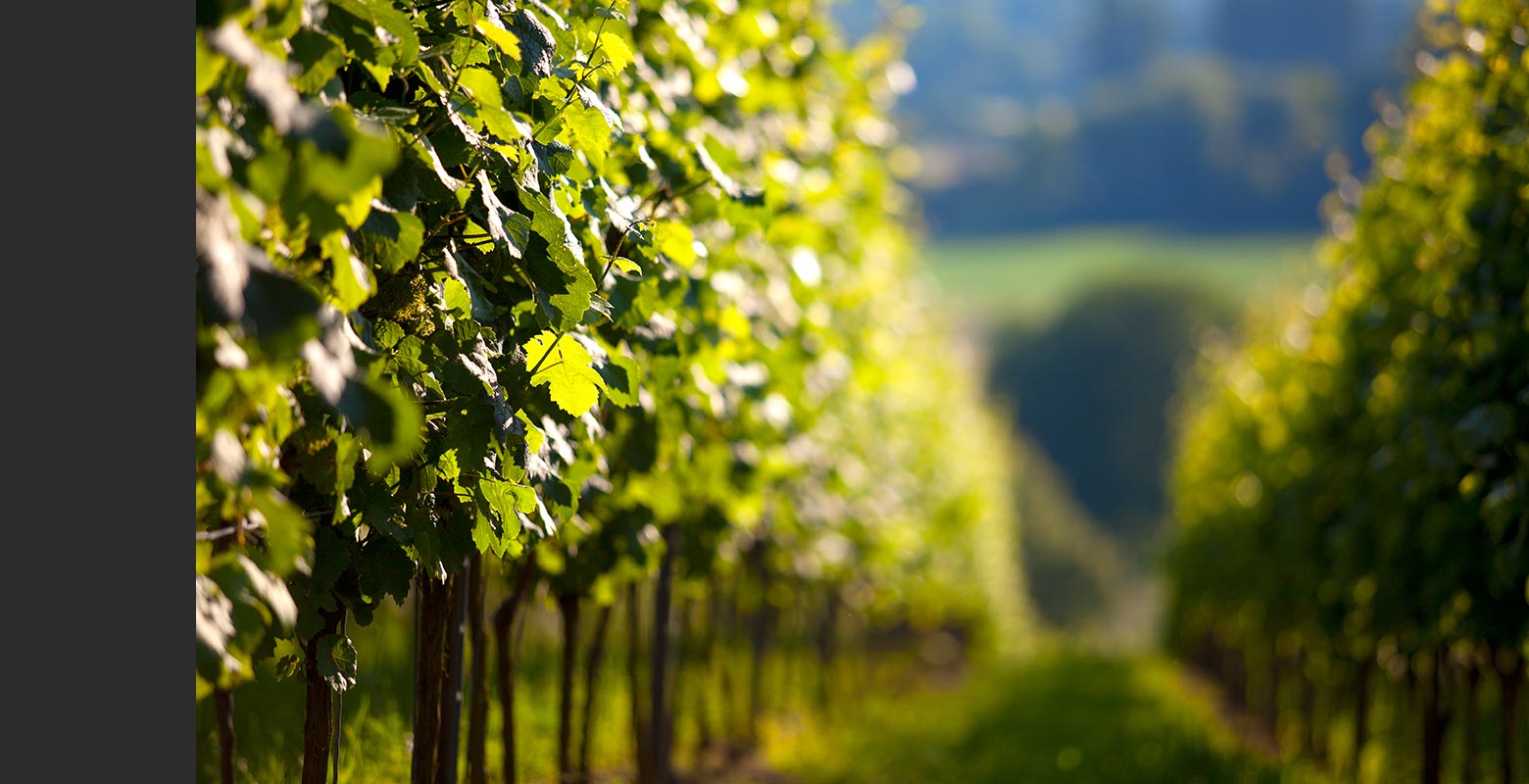Bernard Moreau
" Les résultats de ce travail attentif et précis sont spectaculaires. "
"The results of this painstaking and precise work are spectacular.”
THE MAN
Bernard Moreau is a likeable character who spends most of his time in his vineyards.
In the years since 1982, when he took over from his father, he has built up %u200B%u200Ba 7 hectare vineyard estate, which he manages on his own. He is a perfectionist winemaker, paying particular heed and close attention to anything relating to the environment.
He works in accordance with "Reasoned Viticulture" specifications, aware of the need to gradually reduce treatment products, fungicides, pesticides and insecticides. To do this, he calls on specialized technicians. He works to ensure that his vines are in constant good health and to apply targeted and appropriate treatments, inspecting his parcels each day in order to work more efficiently.
To avoid systematic treatments, some winemakers, including Bernard Moreau, inspect the vine leaves and the grapes, and monitor the presence of insects, whether parasites or vineyard-friendly, to determine whether or not treatments are required. These regular inspections give him a clear view of %u200B%u200Bwhat is going on in his vineyards.
THE VINE
All vines are located on the slopes surrounding the village of Mancey.
The Chardonnay (2 hectares) is planted on two main terroirs:
One facing east (0.75 hectares), with stony limestone soil, brown-red ferruginous soil, giving the wines minerality and good acidity. The vines are now 20 years old.
The other, planted 28 years ago (1.25 hectares), facing southwest, with deep, cool, white limestone marl, producing fruity, smooth white wines.
The Gamay, planted in 1980, mainly in a location known as “Les Cras”, produces fruity, spicy and structured wines.
The Pinot Noir, which covers nearly 3.5 hectares, is planted exclusively on the eastern slope of the hill, also in "Les Cras".
The vines are 18 to 28 years old and are pruned according to the Royat Cordon method, which helps curb production, thereby producing better quality grapes and wines.
With this pruning system, which he has adapted, the grapes are smaller and better spread over the vine, ensuring better ripening and greater balance in the wines produced.
There’s no real explanation for it, but the Royat Cordon pruning method effectively results in smaller size grapes.
THE WINES
The results of this painstaking and precise work are spectacular. His labour is reflected in the quality of the wine obtained, both the white and the red, and is an example to other growers in the area.
The Chardonnay, fermented and aged in barrels (400 litre barrels, of which 25% are new each year, have been used for several years), results in a fruity, rich white Burgundy, with good length. Its minerality is sustained by a distinct freshness, all wrapped up in a nice complexity and displaying remarkable length on the palate.
The gradual move to vinification and ageing in 400 litre barrels has led to a significant improvement to the wine's balance.
Experience has shown that fermentation in 400 litre barrels produces excellent results for the white wine. This ratio of wine-to-wood contact creates wines which are less marked by the wood and which possess a more elegant, refined oaky character.
The Bourgogne red Pinot Noir undergoes a careful, balanced vinification. The delicate character of the grape demands careful fermentation without too much cap punching. Fermentation is therefore more gentle, in contrast to a more "extractive" method, during which the cap punching operations are longer and carried out more frequently in order to obtain more matter.
When it comes to Bernard Moreau's grapes, the fruity, delicate character of the Pinot Noir, grown in this type of soil, requires a more cautious approach to ensure that the wines are not too tannic and hard.
The grapes go into vat and the temperature is lowered to 10-12°C for 5- 6 days to macerate the grape must before fermentation with the grape pulp and skins. This method produces more fruity wines, which usually possess a lovely colour.
The vatting period lasts 10-12 days, after which the juices are drawn off to settle between 48 to 72 hours, before going into barrels.
About 10% of the wine goes into new barrels, the remainder is housed in barrels used for 1 to 5 vintages. All of them are the 228 litre size which, unlike for the white wine, seems better suited to achieving the balance and complexity sought in the wine.
Bottling is generally carried out after only 9-10 months' ageing.
Bernard Moreau
" Les résultats de ce travail attentif et précis sont spectaculaires. "
"The results of this painstaking and precise work are spectacular.”
THE MAN
Bernard Moreau is a likeable character who spends most of his time in his vineyards.
In the years since 1982, when he took over from his father, he has built up %u200B%u200Ba 7 hectare vineyard estate, which he manages on his own. He is a perfectionist winemaker, paying particular heed and close attention to anything relating to the environment.
He works in accordance with "Reasoned Viticulture" specifications, aware of the need to gradually reduce treatment products, fungicides, pesticides and insecticides. To do this, he calls on specialized technicians. He works to ensure that his vines are in constant good health and to apply targeted and appropriate treatments, inspecting his parcels each day in order to work more efficiently.
To avoid systematic treatments, some winemakers, including Bernard Moreau, inspect the vine leaves and the grapes, and monitor the presence of insects, whether parasites or vineyard-friendly, to determine whether or not treatments are required. These regular inspections give him a clear view of %u200B%u200Bwhat is going on in his vineyards.
THE VINE
All vines are located on the slopes surrounding the village of Mancey.
The Chardonnay (2 hectares) is planted on two main terroirs:
One facing east (0.75 hectares), with stony limestone soil, brown-red ferruginous soil, giving the wines minerality and good acidity. The vines are now 20 years old.
The other, planted 28 years ago (1.25 hectares), facing southwest, with deep, cool, white limestone marl, producing fruity, smooth white wines.
The Gamay, planted in 1980, mainly in a location known as “Les Cras”, produces fruity, spicy and structured wines.
The Pinot Noir, which covers nearly 3.5 hectares, is planted exclusively on the eastern slope of the hill, also in "Les Cras".
The vines are 18 to 28 years old and are pruned according to the Royat Cordon method, which helps curb production, thereby producing better quality grapes and wines.
With this pruning system, which he has adapted, the grapes are smaller and better spread over the vine, ensuring better ripening and greater balance in the wines produced.
There’s no real explanation for it, but the Royat Cordon pruning method effectively results in smaller size grapes.
THE WINES
The results of this painstaking and precise work are spectacular. His labour is reflected in the quality of the wine obtained, both the white and the red, and is an example to other growers in the area.
The Chardonnay, fermented and aged in barrels (400 litre barrels, of which 25% are new each year, have been used for several years), results in a fruity, rich white Burgundy, with good length. Its minerality is sustained by a distinct freshness, all wrapped up in a nice complexity and displaying remarkable length on the palate.
The gradual move to vinification and ageing in 400 litre barrels has led to a significant improvement to the wine's balance.
Experience has shown that fermentation in 400 litre barrels produces excellent results for the white wine. This ratio of wine-to-wood contact creates wines which are less marked by the wood and which possess a more elegant, refined oaky character.
The Bourgogne red Pinot Noir undergoes a careful, balanced vinification. The delicate character of the grape demands careful fermentation without too much cap punching. Fermentation is therefore more gentle, in contrast to a more "extractive" method, during which the cap punching operations are longer and carried out more frequently in order to obtain more matter.
When it comes to Bernard Moreau's grapes, the fruity, delicate character of the Pinot Noir, grown in this type of soil, requires a more cautious approach to ensure that the wines are not too tannic and hard.
The grapes go into vat and the temperature is lowered to 10-12°C for 5- 6 days to macerate the grape must before fermentation with the grape pulp and skins. This method produces more fruity wines, which usually possess a lovely colour.
The vatting period lasts 10-12 days, after which the juices are drawn off to settle between 48 to 72 hours, before going into barrels.
About 10% of the wine goes into new barrels, the remainder is housed in barrels used for 1 to 5 vintages. All of them are the 228 litre size which, unlike for the white wine, seems better suited to achieving the balance and complexity sought in the wine.
Bottling is generally carried out after only 9-10 months' ageing.

